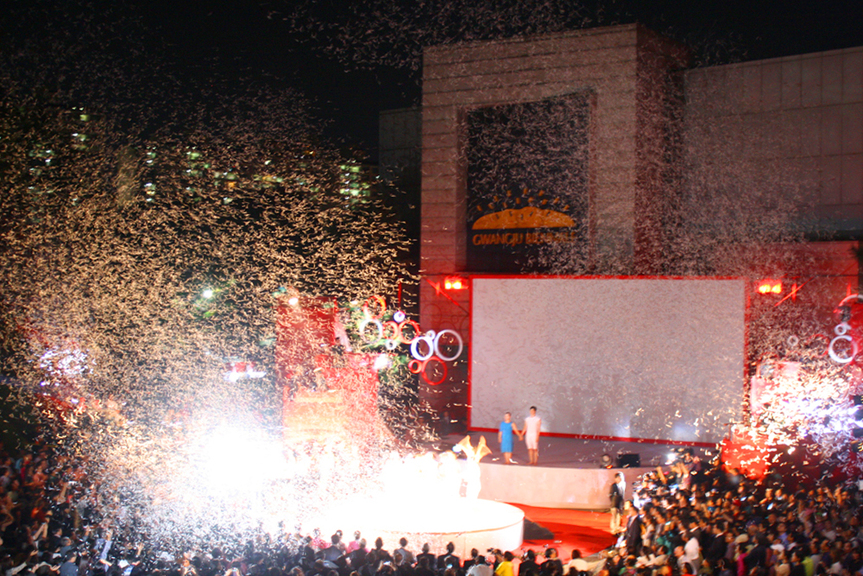The festive and public opening ceremony was held in a packed amphitheater and featured local politicians, movie stars, a modern dance routine, musical acts and confetti.
The plaza outside the Biennale Hall, with visitors playing ping-pong on Rirkrit Tiravanija’s 14 mirror-finished stainless-steel tables, Untitled 2012 (who if not we should at least try to imagine the future, again)(remember Julius Joller) (2012). Each table had two nets, creating a miniature DMZ between the sides.
The six curators taking questions at the Biennale press conference. From left to right: Mami Kataoka, Wassan al-Khudhairi, Carol Yinghua Lu, Alia Swastika, Nancy Adajania, and Sunjung Kim.
In Gallery 1, Michael Joo’s Indivisible (2012), made from 108 overlapping riot shields and clay replicas of ordinary objects (bowls, crutches, stanchions, cell phones), with Julia Dault’s abstract paintings and sculptures in the background.
Do Ho Suh’s architectural structures, part of his “Rubbing Project,” were based on existing spaces, and their interiors were lined with rubbings (frottages) made at the original sites.
Melbourne-based Benjamin Armstrong’s anthropomorphic, tuberous sculptures.
Chosil Kil’s enigmatic abstractions, “Collective Bodies,” incorporate found materials and forms that refer to Gwangju’s Daein Market and a now-closed university building.
Sophia al-Maria’s interest in the futuristic aspects of Gulf state architecture (what she dubs “Sci-fi Wahabi”), here translated to sculpture, with a fiberglass tetrapod (used in the construction of breakwaters) illuminated from the inside.
Abstraction as agony: the beginning of Kim Beom’s maze painting, Untitled (Intimate Suffering #8).
At the entrance to Xijing Men’s installation, visitors are asked to dance, sing or make a goofy face in order to watch their videos.
In Gallery 2, a purpose-built stage area held performances and talks, including this one by the six co-curators.
Yerbossyn Meldibekov’s Seasons in the Hindu Kush (Gindu Kush) (2012) are banged-up pots that refer to the mountain range between Afghanistan and Pakistan during the four seasons. On the walls are hand-tinted images of Afghan women.
Aki Sasamoto’s mid-performance of Centrifugal March (2012), about the forces and objects that bind relationships, even after death. Sasamoto transformed furniture into mobile props, and as she was talking was also simultaneously remixing the live sounds of water running into metal bowls.
Kim Beom’s chicken-esque looking objects, Twelve Sculptural Recipes (2007–11), were on sale during the show; the revenue from the sales goes toward coupons for actual chickens that will then be given to children’s charities.
Rather unfortunately the sign for Carol Yinghua Lu’s section, “Back to the Individual Experience,” was located right next to the restroom. The birth of a new euphemism?
Rasheed Araeen, who founded the journal Third Text Asia in 1987, presented 100 copies on a modular table of his design.
Xurban Collective’s Evacuation #2: Under One Minute focused on the architectural styles of martial-arts training spaces, with a video, props, trophies and images of iconic alpha males.
In Gallery 3, visitors could watch art historian James Cahill’s lectures about early Chinese paintings. In the background are Joseph Dabernig’s metal structures.
A view of Wu Tsang’s 16mm film For How We Perceived a Life (Take 3) (2012), with the projector in the foreground.
In Gallery 4, the winner of the Gwangju Biennale jury prize, was the ersatz sci-fi movie El Fin del Mundo (The End of the World) (2012), with Korean movie stars Lee Jung-jae and Lim Soo-jung.
Sheba Chhachhi’s Record/Resist: Second Wave (2012) featured images from the Subcontinent’s feminist movement; coincidentally at that moment female laborers were sweeping up the space.
The Temple Mugaksa, one of the Biennale’s off-site locations.
Inside the temple were 20,000-plus piles of rice and eight piles of pollen made by Wolfgang Laib, with colored panels by U Sunok in the background.
Downstairs was part of Dane Mitchell’s project, rotating ceramic vessels bearing the images of constellations and a recording of the artist saying the word “now.”
At the Daein market, Kim Beom has the last laugh with his video Yellow Scream, again, as he demonstrates how to paint sound on a canvas.




